Professional services organizations are driving many of the biggest trends in the world of commerce: business transformation, environmental sustainability, remote work, artificial intelligence, to name a few. Scratch the surface of any company’s initiatives in these and other strategic areas and you’re likely to find a management consultancy, engineering firm, IT advisory, marketing agency, accounting group or other professional services provider at work.
And as professional services firms juggle high-stakes engagements with multiple clients, they have their own businesses to attend to. How can these companies deliver high quality for clients while controlling costs and, ultimately, spurring profitable growth? Solid project management delivers on these goals, and this guide describes how.
What Is Professional Services Project Management?
Professional services project management ensures the efficiency, quality and profitability of producing specified deliverables to clients within set scopes, timelines and budgets. As a rule, professional services organizations run their engagements with clients as projects. Project management requires rigorous planning, scheduling, execution and monitoring. Each project can be highly complex, and a professional services provider may have many projects in motion at the same time.
Professional services enable client companies to focus on what they do best — their core business. A manufacturer or retailer operating in today’s complex business environment, for example, relies on professional services organizations for their specialized knowledge and skills in areas ranging from risk management, to merger and acquisition strategy, to green design.
Key Takeaways
- Projects provide the essential delivery mechanism for professional services.
- At any given time, professional services firms are running multiple projects for many different clients.
- Professional services firms can use automation technology to streamline project management, improving profitability.
Project Management for Professional Services Explained
Time is money, and nowhere is this truer than in professional services. Law firms, marketing agencies and other professional groups primarily package their employees’ knowledge and skills as projects along with other amenities. And a firm’s unit of measure is mainly billable hours per individual working on a project. This approach puts a lot of pressure on project managers to accurately break down contracts into tasks, time and expenses. Tracking these moving parts is essential to reporting and billing. Lacking transparent oversight, a project can go off the rails, suffering cost overruns and delays, with client satisfaction and the firm’s profitability at stake.
To keep their engagements on track, professional services organizations are increasingly automating project management and integrating it into their enterprise resource planning (ERP) systems, bridging project management software, customer relationship management (CRM) platforms, financial systems and human resources (HR) databases. Professional services automation (PSA) goes well beyond the old-school approach of using spreadsheets or disparate IT solutions from the beginning to the end of a client engagement — known as the bid-to-bill process.
Meanwhile, some professional services organizations are gravitating toward using a subscription model in addition to traditional project models, such as fixed-price and time-and-materials contracts. Fueled by a desire for more recurring revenue, about half of IT consultancies are already expanding into subscription models or considering such a move, according to the Technology & Services Industry Association. Subscriptions and managed services arrangements are more open-ended than traditional projects in terms of deliverables and even termination dates. An example might be open-ended access to seek advice from management consultants. Like one-off projects, however, subscription arrangements also require close management and oversight to deliver client satisfaction and profitability.
Key Elements of Professional Services Project Management
Key elements of project management for professional services include the sales handoff, project plan, resource plan, project workflow, task management, expense tracking and reporting. Each of these is detailed below.
Sales Handoff
To avoid overpromising and underdelivering, project planning needs to begin earlier than some professionals might expect — that is, before a contract is presented to the client. Experts say that sales representatives and project managers need to initially coordinate at the presales phase of the deal and then have a more formal handoff when the sale is finalized to reinforce exactly what was promised to the client.
Some would argue that there should be no formal handoff at all. Rather, joint status reports, steering committees and other mechanisms should facilitate ongoing collaboration between the sales and project delivery teams from beginning to end. Integration of project management and financial software supports this approach and can also accelerate cash flow, including the automation of invoicing at certain intervals.
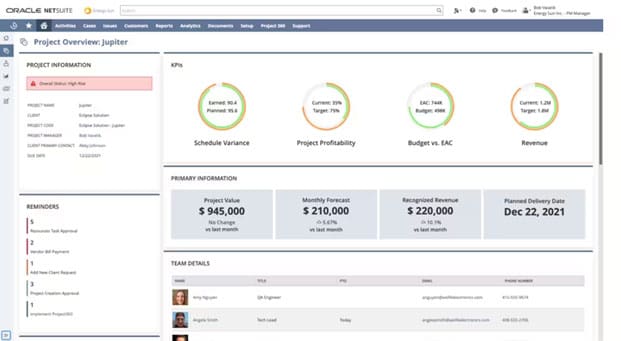
Project Plan
Simply put, a solid project plan makes professional services engagements run more smoothly. Here are the common elements that should be included in an effective project plan:
- Project overview
- Scope and objectives
- Deliverables
- Methodology
- Workflow and tasks
- Timeline
- Resources
- Cost breakdown
- Team structure and roles
- Quality management
- Change and risk management
- Reporting mechanisms and client communications
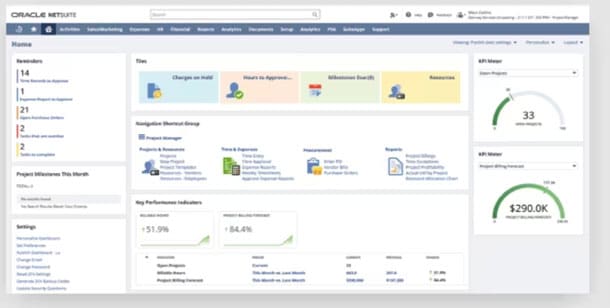
Resource Plan
People represent any professional services organization’s most important resource. In turn, resource planning makes sure the right people are in the right place at the right time, as well as all the materials and support systems needed on a project. An effective resource plan considers the following: What percentage of which subject-matter expert’s time should be assigned to which consulting project — at what billable rate — and is that person available? Are meeting rooms, IT tools and other required supports in place?
Poor resource planning can leave a firm’s employees and subcontractors sitting on the bench when they could be working productively on a project. Conversely, they may be double-booked or show up at the wrong place or time. Scenarios like these carry high costs: waste, delay, dissatisfied clients and low project margins. Project planning systems with dashboards help project managers forecast resources and see exactly what’s going on at any given time so they can avoid underutilization or overallocation of their people.
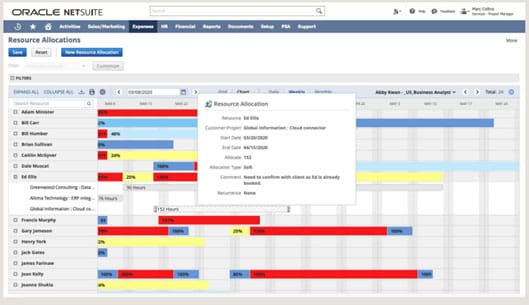
Project Workflow
Before drilling down to the level of individual tasks, project managers need to establish workflows. While project management methodologies can get quite complex, workflow can roughly be equated with project phases. Project managers group sets of related tasks into workflows, each of which may need to be completed before the next set can begin. For instance, a marketing agency that’s handling a client’s product launch might create workflows that include planning, content creation, outreach and others. In this example, planning could involve tasks such as establishing the target audience, gathering market research and defining key messages — all before content creation can begin.
While sequencing is critical to most workflows, some can run in parallel. Sometimes, workflows themselves may be standardized across several projects. In other cases, such as agile project management, workflows are less rigid. Instead, project teams prioritize iterative deliverables followed by feedback and project adjustments. Hybrids of structured and agile project management approaches are also common.
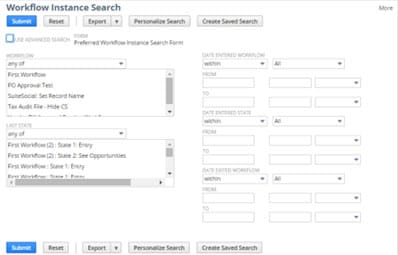
Task Management
A project’s workflow comprises myriad tasks that must be assigned, monitored and reported to track which tasks are in progress, completed or not yet started. Cloud-based software facilitates task management in multiple ways, allowing all project stakeholders to view and update tasks, understand how one task may depend on another and see how close a task is to completion.
Strong task management helps a project manager proactively identify and head off potential issues, such as gaps and delays, while making better use of team members’ time. Gantt charts are often used to visualize tasks against time. These bar charts include start and end dates, as well as priorities and dependencies, within overall project schedules and deadlines.
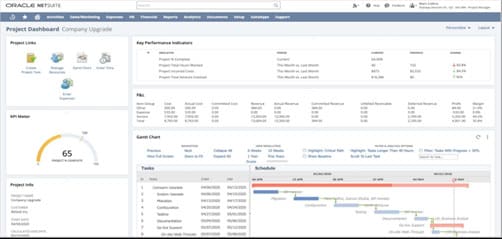
Expense Tracking
Even in today’s era of remote work, project management teams of professionals can incur significant expenses traveling to work with clients on site, among other out-of-pocket expenditures. Automating and simplifying the expense cycle, including reporting, submission and approval, can facilitate rapid reimbursement of team members and, in some cases, client billing, when project management software is integrated with project accounting and invoicing. Whether a project is run under a time-and-materials billing model or a fixed-price contract, understanding expenses in real time can also help a project manager avoid cost overruns.
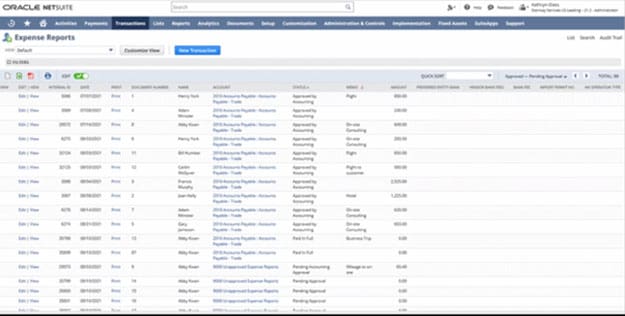
Reporting
Project reports can take many different forms for various stakeholders — from a firm’s senior executives to the sales team, project team and clients. Gathering real-time information readily derived from project management dashboards — and intended to be actionable — the types of reports include:
- Project status reports provide a high-level view of progress and issues.
- Project health reports drill down on the status in more depth.
- Employee utilization reports track work on a per-employee and rolled-up basis.
- Current backlog reviews detail tasks that remain open, including how many hours team members still have to complete them.
- Customer/project profitability reports deliver forecasts based on real-time spending.
- Variance reports focus on changes to a project.
- Risk assessments examine what could go wrong.
- Project completion reports summarize the life of the project and provide lessons learned and recommendations for future projects.
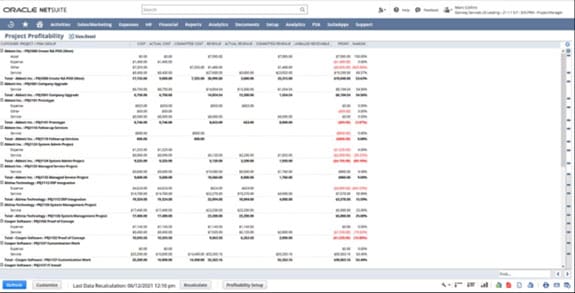
Project Management Challenges for Professional Services
When it comes to project management for professional services, there’s no shortage of challenges. Some center on accomplishing deliverables for the client. Others, although clearly related, have more to do with a project’s profitability. Examples of both types of challenges are listed below.
End-to-End Project Visibility
Projects and all their moving parts need to be effectively managed. That can’t happen without end-to-end visibility. In fact, one of the primary causes of projects going over budget is poor visibility into project status. Challenges that cloud project managers’ visibility include:
- Manual tools, such as spreadsheets shared via email.
- Fragmented IT systems, for example, walling off project data from HR information on the availability of team members.
- Data silos, because of a lack of standard data formats or the use of manual and fragmented tools.
- Human error, in neglecting to update data in real time.
- Process issues, such as the absence of clear processes for collecting and sharing data.
Scope Creep
A lack of visibility may cause projects to drift off course, accumulate additional tasks, time commitments or other baggage, and run into delays, cost overruns and financial losses. There are many causes of scope creep, but they cannot be addressed if they remain unseen. Common causes of scope creep include:
- Client confusion: Either the client doesn’t know what they want from the start or the project manager has not clearly communicated the project’s scope.
- Poor project design: The workflow isn’t properly sequenced, for example, or the time frames are unrealistic.
- No change-control process: Change occurs, as is likely in any project, but there’s no process for keeping it within the project’s constraints of budget and time.
- Insufficient reporting: Team members lose sight of the original plan without routine updates.
Managing Expectations
Emotional baggage, such as anxiety, confusion and ambiguity, can weigh down a project, and much of it comes from mistaken expectations, according to a recent article in the Harvard Business Review. Set too high, expectations can risk disappointment on the part of stakeholders ranging from clients, to bosses, to team members. Set too low, and project teams can become complacent. Left unclear, and every team member could start operating on their own assumptions. Unfortunately, project managers who may have strong “hard” skills in planning and other project technicalities often lack important “soft” skills, such as setting expectations, according to the article.
Team and Client Communication
Over half of professional services work is done remotely rather than on a client’s site or other office setting, according to the Service Performance Insight (SPI) research firm. This distance can strain both team and client communications and lead to poor collaboration among stakeholders.
Efficient Use of Billable Hours
Unfortunately, project teams can sometimes lose potential billable revenue. The culprit in some instances is poor project planning or change management, leaving team members sidelined when they could be working billable hours. Another challenge is itemizing all billable hours, which can include meeting attendance, correspondence and other communications, in addition to work on project tasks. A third is just getting hours submitted by team members, especially if the process is cumbersome. These issues can also have a cascading impact across projects, as a firm may find it difficult to apply a solid understanding of its cost-effectiveness, time requirements and necessary resources from one project to the next.
Resource Allocation
The inefficient use of billable hours represents a big challenge in resource allocation, though not the only one. Most professional services organizations concede that they have difficulty predicting necessary project resources in advance, for reasons including client churn. Exacerbating resource allocation problems is the fact that the average annual employee attrition rate at professional services firms has averaged 12% to 14% for the past five years and is expected to grow, according to SPI. And companies that rely on networks of external consultants also face an ongoing talent crunch in the market.
Benefits of Project Management in Professional Services
Modern project management techniques address challenges using evolving models, processes and technological innovations. According to the Project Management Institute’s Pulse of the Profession 2021 report, project managers have derived a number of benefits from effective project management, including more projects completed on time (55%), within original budget (62%) and meeting business objectives (73%). These and other project management key performance indicators (KPIs) have shown steady improvement over previous years, providing significant benefits.
Defining Roles and Goals
Depending on the project, the roles and goals within an engagement could include the following (with a single person often wearing multiple hats in smaller firms):
- Project sponsor: Typically, a senior executive in the firm who advocates for the project, builds relationships with clients and makes final decisions.
- Project manager: Plans and manages the engagement, assembles a team and works with contractors to deliver on time, within budget and at high quality.
- Team members: Contribute expertise and skills to work collaboratively and complete assigned tasks on schedule.
- Budget and financial analysts: Manage project finances and track expenditures to meet budget.
- Project management office (PMO) director: Leads the firm’s PMO office to define and oversee project management best practices, methodologies and allocations to be used across projects.
Keeping Teams Aligned and Focused
Project managers have many tools and techniques at their disposal to keep teams on task. The greatest asset should be the project plan itself, with clear goals, objectives, schedules and KPIs, and the plan should be communicated and well-understood by team members. Meetings, including kickoffs and regular progress meetings, help keep everyone on the same page. Team structure can be used to advantage. For example, in the agile model of project management, scrums collaborate daily in small groups to complete work in short cycles, called sprints. Mobile applications can update centralized dashboards, unifying teams around real-time views of progress and issues.
Prioritizing Resources
Project plans don’t only identify which subject-matter experts and other resources should be working on what aspects of a project. They also prioritize the team’s work based on timing, relative importance and dependencies among tasks. Dashboards with tools, such as Gantt charts and KPI completion gauges, provide all team members with a centralized view of what tasks are complete and what they should prioritize next.
Setting Accurate Scope, Schedule and Budget
A requirements gathering process sets the stage for an accurate scope, schedule and budget. A simple example might be determining the client’s deadline, but this is just one of many specifications, constraints and deliverables that need to be included. Other techniques for scoping a project include:
- Work breakdown structure: Identify tasks and the relationships among them.
- Analogous estimation: Calculate based on historical data from similar projects.
- Bottom-up estimation: Calculate the time, expenses and other requirements of each individual task and then roll them up into a top-line estimate.
- Top-down estimation: Work down from already established budgets or deadlines.
- Critical path method: Establish the necessary sequencing of tasks to be represented in a Gantt chart.
Improving Risk Management
Project management enhances risk management for professional services firms by providing a structured framework to identify, assess and mitigate potential risks throughout the project life cycle. Project plans should include risk assessments and planning to identify, risk-rate and mitigate potential problems that could prevent a project from succeeding. The theory is that it’s less costly to head off issues than to deal with them after the fact.
Managing Complexities and Issues
Project management plans should define a system for documenting any risk that materializes into a full-blown issue, as well as a procedure for root-cause analysis of what happened. Reserves should be set aside in the budget. Escalation procedures in the project plan need to ensure that team members understand how to report incidents. Change management also represents a crucial aspect of a project plan, enabling the team to pivot around complexities and issues that arise by triggering an approvals process for any significant changes to the scope, time or cost of any project deliverable.
Refining Organizational and Project Planning
Regular project reviews should be scheduled in the project plan to assess progress, identify issues and opportunities and refine organizational and project planning. Among the agenda items for any review are fulfillment of tasks, compliance with project guidelines and adherence to the budget.
Optimizing Human Talent, Know-How and Reputation
It bears repeating that people represent the most important resource in project management. Clients are essentially buying the knowledge, skills and reputation of the professional services firms they work with. Within a project plan, subject-matter experts and other senior team members should be put to the best use where needed most, with deliberate resource planning. Careful talent management and scheduling should facilitate their work and avoid any overallocation, underutilization, conflicts, bottlenecks or other causes of waste and burnout. The budgetary impact of any of these unfortunate events could be high, in terms of billable hours. But the talent loss could be even greater in a market characterized by more demand than supply.
Ensuring Consistency Across Projects
Project management reports should be designed to not only capture a project’s status, but also deliver lessons learned and other valuable input for the next project. At the end of a project, lessons-learned sessions should analyze the metrics, root causes and other aspects of documented successes and failures, which should also be collected in a repository for retrieval by other project managers. Successful professional services firms use input like this to improve quality and standardize delivery methodology. Consistent delivery across multiple projects can also be facilitated by digital project templates.
Improving Resource Planning and Allotment
Incorporating the steps above can bring a professional services organization full circle to improving resource planning and allocation on the next project. With a growing body of knowledge about their firm’s clients, employees and project results, PMOs, project sponsors and project managers can move on to the next engagement with greater confidence and success.
10 Best Practices to Manage Professional Services Projects
Here are some quick tips and takeaways to tackle the challenges and maximize the benefits of project management.
-
Plan early, even pre-project.
Planning early can align the sales and project management teams to avoid overpromising, underdelivering or eroding project margins with costly changes in scope. In this case, early means presale and pre-project.
-
Balance resource availability.
Careful resource planning, empowered by centralized dashboards, can show a project manager which subject-matter experts are available to take on an assignment, when they’re free and at what capacity they can contribute. That way, the best people can be assigned without overloading them, while no one is left sitting idle.
-
Maintain consistent communication.
Project stakeholders need real-time, centralized information graphically presented on easily accessible dashboards. Wherever they are, whenever they’re working, team members should be able to update their tasks, as well.
-
Clearly define project scope.
Everyone on the team needs to be working toward the same goals, objectives, timelines and budgets. A clearly defined project scope can be reinforced by project-based milestones and dashboards with KPI gauges and alerts for improved visibility and control.
-
Standardize risk and error reporting.
Escalation procedures put team members on notice that they’re expected to report errors while giving them the tools they need to do so promptly. Project management software can help reduce the risk that errors will do serious damage by recording project issues down to the task level and tracking their resolution process with descriptions, severity, dates and assignments.
-
Monitor time and expenses closely.
Team members’ time and expenses typically represent the bulk of a project budget. Yet, some on the team can be slow to submit timesheets and expense reports, risking surprise cost overruns. Set a reporting policy and automate where possible. Make it easy to submit and track these costs with mobile apps feeding into integrated project management and financial software. Then routinely monitor, analyze and adjust spending as needed.
-
Track customer satisfaction.
Client feedback meetings should gauge customer satisfaction on a regular basis. While these unstructured discussions can be critical to ensuring smooth sailing for the project at hand, they can also deliver important benefits of relationship building and prospects for future work. At the end of an engagement, more structured customer feedback surveys, interviews and focus groups can help determine customer satisfaction scores.
-
Compare project progress with contract terms.
Project management software integrated with financial systems can lay out all the information needed to compare project progress with contract terms. This includes project budgets, estimates, work in progress, percentage complete, invoices, billing milestones and actual costs.
-
Conduct weekly team meetings.
Getting everyone in the same room or on the same conference call reinforces that they’re all working toward a common goal, while also fulfilling the practical need for project status updates. Weekly meetings represent just one of the many types of project meetings that might be required, such as kickoff meetings at the start of the project, regular check-ins during a sprint on a particular task and post-mortems upon completion.
-
Present timely data to executives.
Project managers need budgetary and other support from senior executives at their firm, starting with their own project sponsor. Project managers need to avoid falling into the trap of applying best practices throughout a project only to have it fail because of executive inaction or counteraction within their company. Timely data in highly graphical format can keep senior executives informed and engaged.
Why Use Software for Professional Services Project Management
Cloud-based professional services automation (PSA) enables project collaboration, sharpens reporting and optimizes resource management — all of which can improve profit margins on client engagements. PSA works best when it integrates ERP systems with project management software and systems for finances, CRM and HR. Connecting the dots, these integrated systems let project managers and other stakeholders visualize and analyze projects in real time across vital information such as KPIs, completion rates, costs, interaction with clients and availability of personnel. PSA can streamline project operations as it replaces older alternatives that rely on spreadsheets, task boards, email and disconnected IT systems.
Improve Project Collaboration and Track Time and Expenses Easily with NetSuite
NetSuite ERP, project management, accounting, CRM and HR systems operate in tandem to give professional services project managers the power to orchestrate multiple, complex engagements. The Project 360 Dashboard provides a consolidated view of the status of all projects, while clicking through to individual projects reveals important KPIs at a glance, including project profitability. Armed with the latest updates, managers can then move seamlessly to the next steps, making assignments, scheduling and taking corrective measures.
Professional services organizations thrive when they fulfill their client engagements with high efficiency, quality and repeatability. Project managers increasingly rely on professional services automation to align the key dimensions of their projects — across sales, HR, budgeting, operations and client relations — to elevate their performance and profitability. The proof is in their steadily improving track record of projects completed within budget, on time and in line with business objectives.
World's #1
Cloud PSA
Software
Project Management for Professional Services FAQs
What is a PMO?
A professional services firm’s project management office (PMO) establishes and oversees how projects are managed for clients. The PMO’s responsibilities include setting firmwide standards and methodologies, aligning projects with the firm’s business strategy and facilitating successful execution of projects.
What does a professional services manager do?
Professional services project managers oversee the fulfillment of client projects by designing and running projects. The manager’s responsibilities include the following: defining project goals and team members’ roles, keeping teams aligned and focused, prioritizing resources, setting the schedule, producing a budget, managing issues that arise, keeping the project within its intended scope and ensuring consistency from one project to the next.
How do firms manage client expectations and project feasibility?
Professional services firms work hard to establish relationships with clients to ensure successful client engagements and repeat business. For example, professional services project managers meet regularly with their clients to deliver status reports and seek feedback. Graphical presentations derived from project management dashboards can give clients a clear sense of progress. Client satisfaction and clarity regarding the project’s scope and methods can help to keep a project from expanding in unnecessary directions, including the addition of new, time-consuming tasks.
What are professional services in project management?
Professional services are typically delivered in the form of projects run by a designated project manager. Examples of professional services projects might include a process improvement engagement by a management consultancy, the implementation of a regulatory compliance management system by a risk management consultancy or the initiation of a new digital system by an IT consultancy.
Is project management considered professional services?
Professional services firms run most of their client engagements as projects. That said, companies of all sorts run their own projects internally, as well, ranging from product development to change management to digital transformation.





